Defining success in bushfire management: critical moments in the 2012-13 ACT bushfire season
Peer-reviewed Article
Submitted: 29 March 2017. Accepted: 29 April 2017.
Abstract
Article
Introduction
The successes of bushfire managers are rarely acknowledged by the community because their work passes largely unnoticed unless there’s a catastrophic failure. In effect the scale of success ranges from zero to minus-10 with zero awarded when there are no lives lost, no property damaged and no adverse environmental outcomes. Bushfire and land management agencies are aware of this perverse situation (Eburn & Dovers 2012). For example, Mick Keelty (2011) in his review of the Perth Hills fire stated:
There remains one question the answer to which eluded the Special Inquiry but it is an answer that requires further examination and that is: What is the measure of success of the outcome of a bushfire (sic). Is the loss of no lives the only performance measure? If so, how many houses is an acceptable number to lose? Does one performance indicator have the potential to cloud the ‘Shared Responsibility’ of all to build resilience of our community?This paper is a case study from the successful 2012-13 fire season in the Australian Capital Territory (ACT) with the aims of:
- highlighting the critical factors that contributed to the outcome
- examining the implications of the events for defining robust measures of success in bushfire management.
Preparing for the season
Heading into the 2012-13 fire season, the ACT had experienced two years of record rainfall brought about by the coincidence of a positive Southern Oscillation Index (La Niñaconditions), a negative Indian Ocean Dipole and a positive Southern Annular Mode (Bureau of Meteorology 2012). This caused rapid grass growth particularly of the exotic pasture species Phalaris aquatica that could not be consumed by livestock as quickly as it grew. This resulted in high fuel loads up to 12t/ha-1 (Leavesley et al. 2012) and high fuel continuity within the grasslands, woodlands and dry forests that surround and dissect Canberra. The climate outlook for the 2012-13 fire season was for below-average rainfall, average temperatures and for a reduction in soil moisture as the season progressed. The immediate concern for fire managers was that damaging grass fires were possible as soon as curing was greater than 70 per cent and that the potential for forest fires may develop as forest fuel moisture declined.
Bushfire management in the ACT is the responsibility of the Emergency Services Agency (Emergency Services Agency 2009), however, the role of the ACT Parks and Conservation Service is important for several reasons:
- It is the largest land manager - 72 per cent of ACT is zoned National Park or Nature Reserve (ACT Auditor-General 2013).
- It provides 150 bushfire-trained personnel (i.e. approximately one-quarter of the ACT bush firefighters).
- It is responsible for meeting the fuel management standards in the asset protection zones around the city.
- It is responsible for delivering much of the ACT’s bushfire infrastructure such as fire trails, helicopter pads, stock fences and water points (ACT Government 2012).
The wet weather through the summer of 2010-11 was a welcome change for Parks and Conservation bushfire fighters. Agency firefighters were authorised to take the public holidays over Christmas 2010. The season ended with the fire management unit budget underspent due to the small number of hours spent stood-up, minimal expenditure on fire suppression and the reduced expenditure on the burning program. While the burning program was delayed, the physical fuel removal program, which involved the construction and maintenance of defensible space across the Canberra urban-rural interface (Emergency Services Agency 2009), was ahead of schedule. The other factor that occupied fire management staff during the season was repair of the fire access trails following a major storm event on 3 December 2010. Temporary repairs re-established light-unit access to most of the mountain country but the full network of trails required for heavy tankers and floats was scheduled to take many months.
Preparations for the end of the wet weather commenced at the end of the fire season with the development of the 2011-12 Bushfire Operations Plan (BOP). The plan recognised that the burning program was behind schedule and, in addition, the ACT region had an unusually high fuel load of cured grass (Cheney et al. 1998) that would need treatment. In the ACT, burns cannot be conducted by contractors so a case was made—and granted—for additional seasonal fire crews. In parallel, an internal research project was launched to investigate the effect of winter burning on grass fuel loads during the following summer (Leavesley et al. 2012). With fuel hazard reduction burning restricted in spring due to ecological considerations (Kitchin & Matthews 2012), winter burning could provide greater capacity to reduce fuel without employing more staff.
In late August 2011 the Bureau of Meteorology presented data at the AFAC Conference that showed that many strong La Niña events last for two years and some for three (Bureau of Meteorology 2012). This was the first indication for many ACT bushfire staff that above average rainfall conditions may continue into a second year.
The extra seasonal fire crews brought the physical fuel removal program even further ahead. The burning program got further behind and the fire management unit budget was further underspent. Another big storm in March 2012 caused even more severe damage to the rural road network than the one the previous summer. On the plus side, the grass research project showed that burning in winter, when the fuel loads were at 12t/ha-1, delivered a fire management benefit the following summer because the treated areas had lower fuel loads and higher fuel moisture than untreated sites (Leavesleyet al.2012).
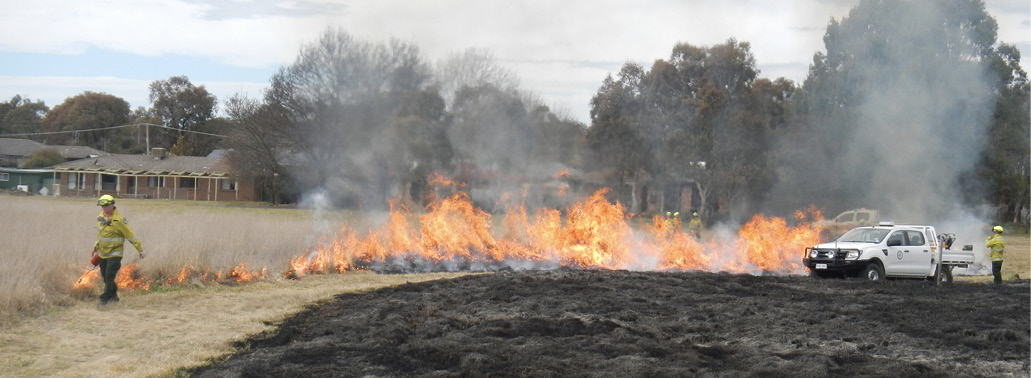
Hazard reduction burning in heavy Phalaris grass at Fraser on the Canberra urban-rural interface in August 2012. Image: Tom Gibbs
Putting all the fires out
The 2012-13 BOP made a case for additional bushfire seasonal crews, which was granted. An intensive program of grass burns in the urban-rural interface was conducted through the winter and by mid-spring the Parks and Conservation Service fire management crews were well practiced. In early December a fire that started to the north-west of the ACT crossed the border and burnt fiercely through grassland until it was brought under control in the evening. At that stage it was clear that the long-awaited, post-rain bushfire season had arrived.
On the afternoon and evening of 5 January 2013 a lightning storm caused multiple ignitions across the ACT and an Incident Management Team (IMT) was set up. Two fires in remote alpine areas near the NSW border were of particular concern. One of these was high on the Brindabella Range adjacent to Mount Franklin Road. It was burning towards one of the most important ecological assets in Australia, the Ginini Flats wetland. Ginini Flats is a one of the few places that supports the critically endangered Northern Corroboree Frog (Pseudophryne pengilleyi, DSEWPAC 2013). The other fire was high on Sentry Box Mountain in rugged, untracked country accessible only by helicopter.
The following morning crews completed the mop-up of accessible sites. At the same time a D4 bulldozer was working its way into the Ginini fire followed up by a D6 bulldozer. The rapid deployment of the bigger machine was only possible due to the recent completion of an upgrade to Mount Franklin Road by the Parks and Conservation Service. The Divisional Commander directed the machines around a European heritage site and down to the fire that was burning in a south-easterly direction towards the Ginini Flats wetland and backing slowly down a steep slope where access was only possible on foot or by helicopter. The two machines separated when they reached the burnt ground and began a flanking movement (Figure 1). At Sentry Box Mountain two winch-qualified Remote Area Fire Teams (RAFT) were deployed with dedicated aerial resources. In this remote location on the east face of the mountain, the two crews used dry firefighting techniques against two-metre-high flames. Aerial resources were increased but the task was difficult.
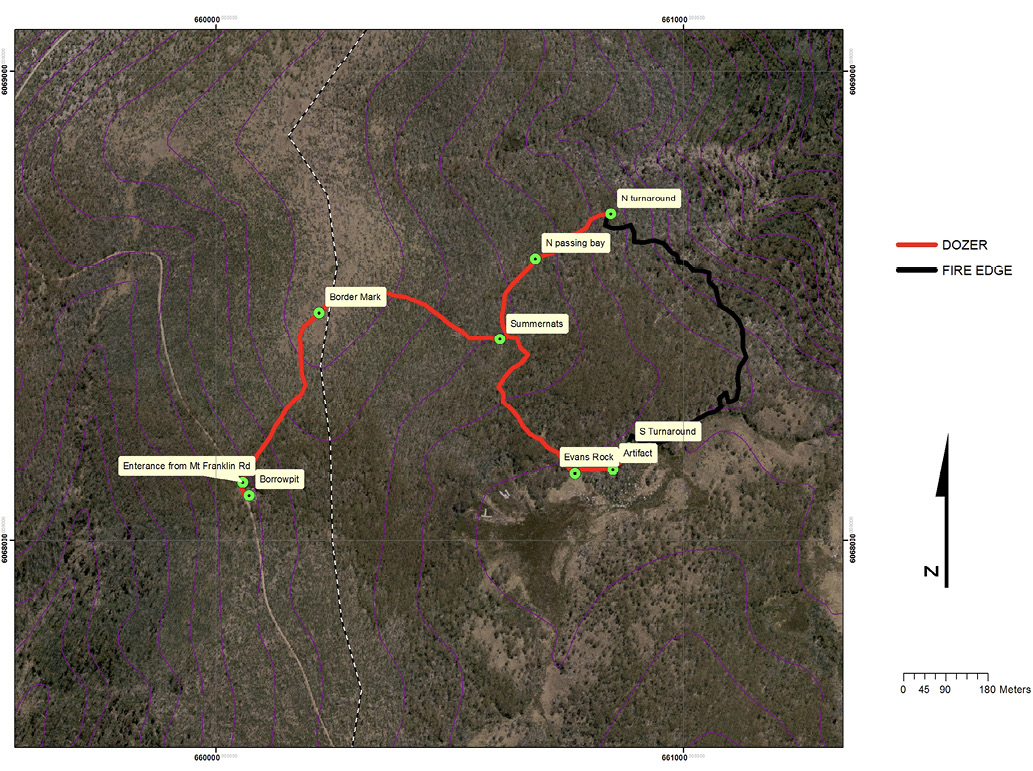
An aerial photo of the site of the Ginini fire that was ignited by lightning on 5 January and extinguished on 7 January. The Ginini wetland, the low ground immediately adjacent to the southern edge of the fire supports the critically endangered Northern Corroboree Frog. Bulldozers were directed around the historic ACT-NSW border mark by the Divisional Commander. The extent of the fire was 26ha but planning for containment lines in the event that it got away encompassed 70,000ha.Figure 1: Site location of the Ginini fire in the mountains surrounding the ACT.
Time was of the essence as the weather forecasts for 6 and 7 January was for High Fire Danger with afternoon storms. Catastrophic fire weather was predicted for 8 January. Planners calculated that if the fires escaped containment they could burn out 50,000ha in the first 24 hours and the final contained size was likely to exceed 70,000ha.
At Ginini, the southern flank of the fire spread into the wetland ahead of the approaching bulldozer. Luckily, timely, well-aimed helicopter drops extinguished the outbreak (Figure 2). The rugged eastern edge of the burn also received concentrated aerial water-bombing activity. At about 4:30pm a thunderstorm moved across the ACT delivering much-needed rain but also more lightning.
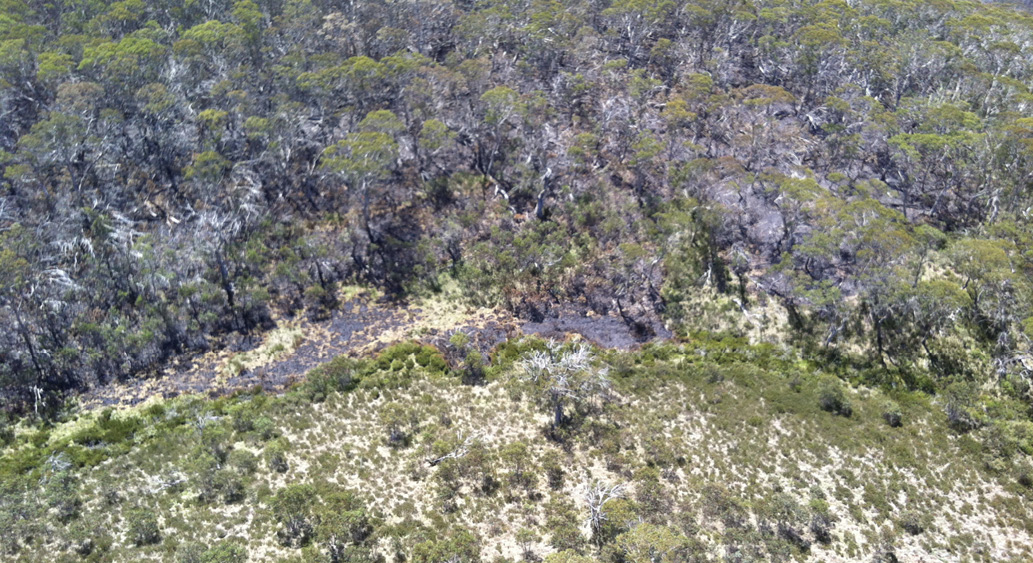
The Ginini fire beat the bulldozer to the Ginini wetland (middle of picture) but was extinguished by helicopters before it could run up the hill (foreground of picture). The control line and vehicle turnaround is faintly visible in the middle of the picture beyond the tree line. Figure 2: Burnt areas on Mount Ginini.
On the morning of 7 January 2013 resources were marshalled in a final attempt to put the fires out. At both fire sites the intensity was much reduced and by 4:30pm both commanders considered the fires contained. Throughout the day the IMT organised searches for new ignitions and nothing was found. Attention turned to preparing for the catastrophic weather forecast for the following day.
On 8 January firefighters assembled for briefings. Catastrophic weather arrived as forecast and winds were so strong during the afternoon that the helicopter fleet was grounded. Fifteen ignitions occurred but the patrolling staff were able to get to all of them before they became uncontrollable. One ignition to the west of Canberra fortunately occurred next to a patch of sand that restricted its spread until crews arrived. The fire had the potential to cross the paddocks and threaten the suburbs of Canberra. The crews on the Sentry Box Mountain and Mount Ginini were proven to have done their job thoroughly and the ACT avoided what could have been a repeat of 2003. The success that day—10 years after devastating 2003 fires—was the key to the whole season. An environmental team assessed the Ginini fire site on 11 January and rehabilitation of the bulldozer trail was completed before the end of the month.
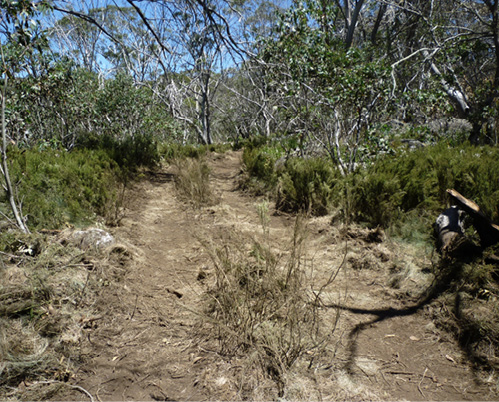
The northern containment line after the fire. The bulldozers were instructed by the Divisional Commander to retain topsoil to aid rehabilitation. The D4 removed the shrub layer while the bigger blade on the D6 was used to remove branches from the Snow Gums (Eucalyptus pauciflora). Image: ACT Parks and Conservation Service
Conclusion
The ACT Parks and Conservation Service can point to a range of factors that contributed to positive outcomes during the 2012-2013 bushfire season.
- The advance allocation of additional resources (seasonal firefighters) in the lead-up to the expected difficult fire season. Fire risk varies from season to season due to stochastic factors (e.g. Allan & Southgate 2002) and small jurisdictions such the ACT and Northern Territory have limited scope to reallocate resources within recurrent budgets so this was a welcome development.
- The planned focus on grass fuel treatment activities, backed up by research (Caryet al.2009; Leavesleyet al.2012, Gibbonset al.2012, Penmanet al.2013, 2014) through the winter and spring of 2012 ensured that defensible space was created most cost-effectively in the most important place, immediately adjacent to assets.
- The high state of readiness of the Parks and Conservation Service crews following the intensive pre-season fuel management program.
- The focus on the repair and upgrade of the fire trail network, in particular the major access route along Mount Franklin Road.
- The clarity of understanding of the importance of fire weather in determining fire behaviour (Cheneyet al.1998, Gouldet al.2007) and the extinguishment of all going fires prior to the forecast catastrophic weather of 8 January (Caryet al.2009, Penmanet al.2014).
- The commitment of maximum resources to early suppression of ignitions that occurred on 8 January (Caryet al.2009, Penmanet al.2013, 2014).
But this is not the whole story. The outcome in the ACT was close and good fortune with the weather and the location of ignitions played a large part. The Sentry Box Hill fire was next to a large natural clearing that facilitated early deployment of RAFT crews and increased the safety margin. The Ginini fire occurred near to a recently upgraded road that allowed rapid access by suitable plant. The 15 ignitions that occurred on 8 January were in locations and at times that allowed them to be extinguished. Benign weather conditions on 6-7 January aided containment of the Sentry Box Mountain and Ginini fires. Had any of these situations developed differently then the ACT may have experienced a season in which the extent of land burnt was near the maximum recorded in the fire history. The size of the jurisdiction is clearly important in this respect. ACT authorities had to deal with several hundred lightning strikes and two fires of concern, while those in NSW and Victoria had to deal with many thousands of lightning strikes and hundreds of fires. In this context the success rate of the ACT in completing operational tasks is unlikely to be exceptional. Had the ACT fires not been contained then the proportion of the area of the jurisdiction that would have been burnt would have far exceeded the proportion of NSW and Victoria that were burnt.
Regardless of what might have been, the 2012-13 ACT fire season saw no loss of life, no major property loss and minimal environmental damage. It was therefore by normal measures successful. This examination of events highlights the successful strategies and illustrates that the outcome was not entirely within the power of fire authorities to control. This situation is relevant to all Australian jurisdictions and acceptance of this situation within communities is an important step in building the resilience described by Mick Keelty (2011). There is inherent tension in a definition of success based on the number of human lives lost, property destroyed or damage to the environment. While an agency can be held to account for ‘plans and procedures’ (Eburn & Dovers 2012) such as meeting targets for trained staff, meeting fuel management standards, maintaining fire trails and success in extinguishing ignitions within a fixed timeframe, it is not logical to hold them accountable for outcomes that are beyond their control. This examination supports the view of Mick Keelty (2011) that a particular danger in adopting measures of success for bushfire agencies that focus on outcomes described by Eburn and Dovers (2012) as perhaps ‘aspirational’ is that it implicitly contradicts the need for increased community engagement and acts to negate efforts to build community resilience.
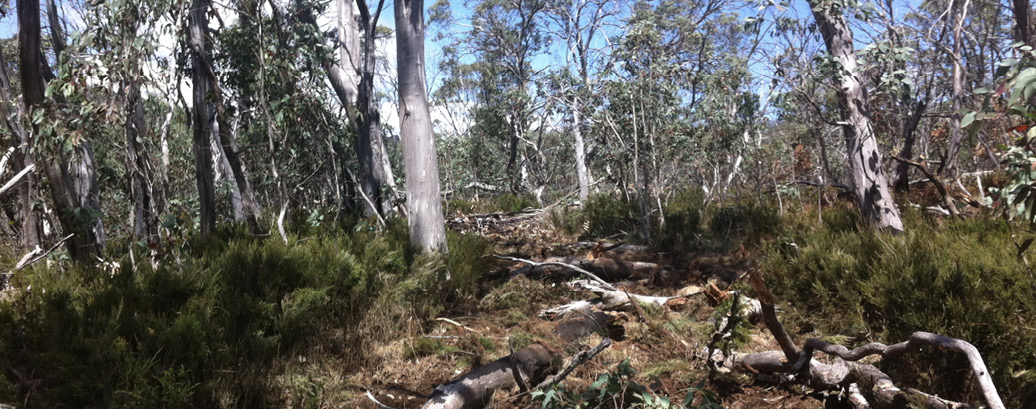
The northern containment line after rehabilitation. Logs, litter and topsoil were scattered over the containment line by an excavator supported by a fire management crew. If the fire had broken containment, staff would have been committed to suppression and rehabilitation would have been delayed. Image: Chris Troth
Acknowledegments
Thanks to Peter Galvin, Scott Farquhar, Simon Bretherton, Trish D’Abrera and Lexi Williams for their recollections of events described in this paper. Special thanks to Chris Troth, Tom Gibbs and the other photographers who contributed their work. Extra special thanks to our colleagues in the Parks Brigade, ACT Rural Fire Service, ACT Fire and Rescue, plant operators and pilots who turned out during the season.
References
ACT Auditor-General 2013, Performance Audit Report – Bushfire Preparedness, Report No. 5/2013. At: www.audit.act.gov.au/auditreports/reports2013/Report%20No%205%20of%202013%20Bushfire%20Preparedness.pdf [18 September 2013].
ACT Government 2012, 2012/13 Bushfires Operations Plan.
Allan GE & Southgate RI 2002, Fire regimes in the Spinifex landscapes of arid central Australia. Flammable Australia: The Fire Regimes and Biodiversity of a Continent, Eds Bradstock Williams RA, Gill JE, Cambridge AE, University Press, Cambridge.
Bureau of Meteorology 2012, Record Breaking Events – An Analysis of the La Nina Life Cycle and the Impacts and Significance of the 2010-11 and 2011-12 La Nina Events in Australia. Commonwealth of Australia, Canberra.
Cary GJ, Flannigan MD, Keane RE, Bradstock RA, Davies ID, Lehihan JM, Li C, Logan K & Parsons RA 2009, Relative importance of fuel management, ignition management and weather for area burned: evidence from five landscape-fire-succession models, International Journal of Wildland Fire, vol. 18, pp. 147-156.
Cheney P, Gould JS, Catchpole WR 1998, Prediction of fire spread in grasslands. International Journal of Wildland Fire, vol. 3, pp. 31-44.
DSEWPAC 2013, Pseudophryne pengilleyi (Northern Corroboree Frog) Listing Advice, Commonwealth of Australia. At: www.environment.gov.au/biodiversity/threatened/species/pubs/66670-listing-advice.pdf [7 August 2013].
Eburn M & Dovers S 2012, Mainstreaming fire and emergency management across legal and policy sectors: Preliminary Findings on Measures of Success. Australian Journal of Emergency Management, vol. 27, no. 2, pp. 14-19
Emergency Services Agency 2009, Strategic Bushfire Management Plan for the ACT Version 2, ACT Government, Canberra.
Gibbons P, Van Bommel L, Gil AM, Cary GJ, Driscoll DA, Bradstock RA, Knight E, Moritz MA, Stephens SL & Lindenmaye DL 2012, Land management practices associated with house loss in wildfires, Public Library of Science, vol. 7, no. 1, e2912.
Gould JS, McCaw WL, Cheney NP, Ellis PF, Knight IK, Sullivan AL 2008, Project Vesta: Fire in Dry Eucalypt Forest Fuel Structure, Fuel Dynamics and Fire Behaviour, CSIRO Publishing.
Keelty M 2011, A Shared Responsibility: The Report of the Perth Hills Bushfire, February 2011 Review, Government of Western Australia 2011, Transmission Letter 3.
Kitchin M & Matthews H 2012, 2012-13 Ecological Guidelines for Fuel and Fire Management Operations, Internal Report 2012/01. Conservation Planning and Research, Environment and Sustainable Development Directorate. At: www.environment.act.gov.au/__data/assets/pdf_file/0007/902968/2_2012-13_Ecological_Guidelines_FINAL_for_web.pdf[17 September 2013].
Leavesley AJ, Mallela J, Corrigan A, Bretherton S, Kendall D & Cooper N 2012, Is there any point burning or grazing grass in winter? Proceedings of the Australasian Fire and Emergency Services Council Conference, p 82, Perth 28-30 August.
Penman TD, Collins L, Price OF, Bradstock RA, Metcalf S & Chong, DMO 2013, Examining the relative effects of fire weather, suppression and fuel treatment on fire behaviour. Journal of Environmental Management, vol. 131, pp. 325-333.
Penman TD, Bradstock RA & Price O 2014, Reducing wildfire risk to urban developments: simulation of cost-effective fuel treatment solutions in south eastern Australia. Environmental Modelling and Software.
About the authors
Adam Leavesley is a bushfire scientist and a member of the Remote Area Fire Team.
Neil Cooper is the manager of the ACT Parks Fire Management Unit.
Dylan Kendall was a Planning Officer in the ACT Incident Management Team.
Tony Corrigan was Divisional Commander of the Sentry Box Mountain fire.
Malcolm Gale was Air Supervisor for the Ginini fire.
Brett McNamara was the Divisional Commander of the Ginini Fire.
Jennie-Ann Mallela is a specialist in ecological disturbance at the Australian National University.


